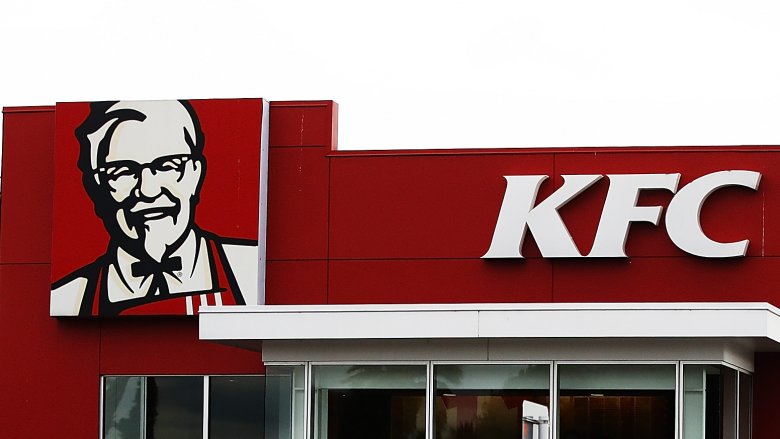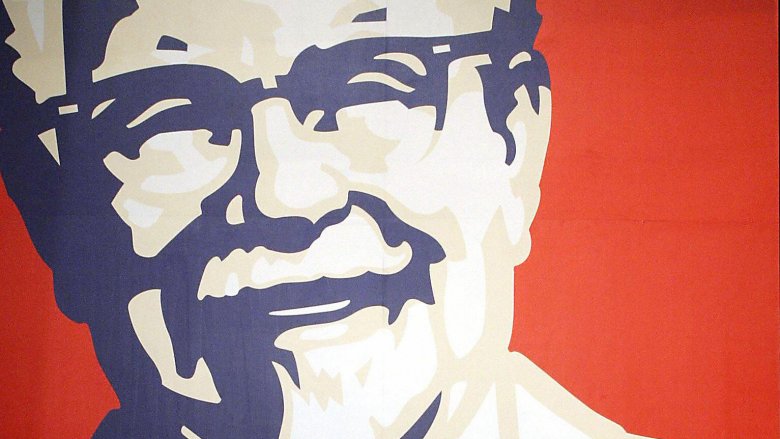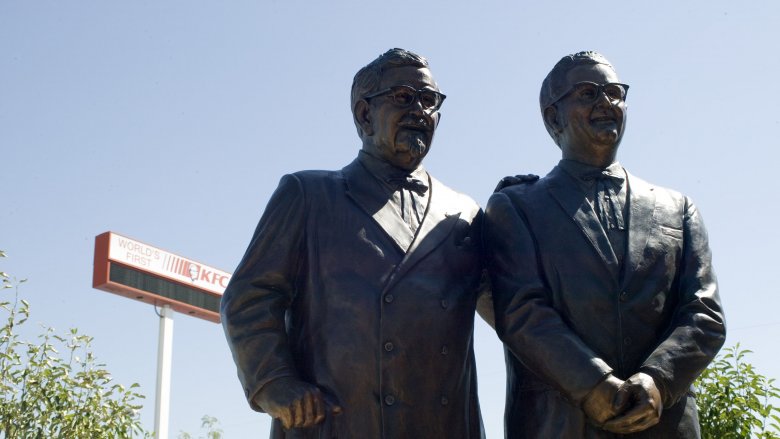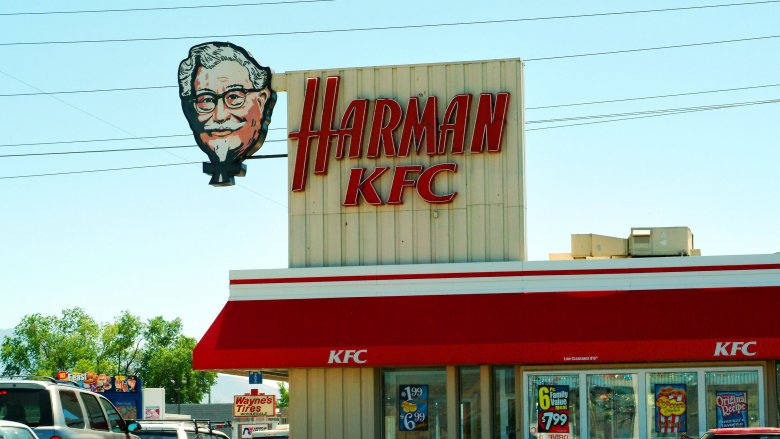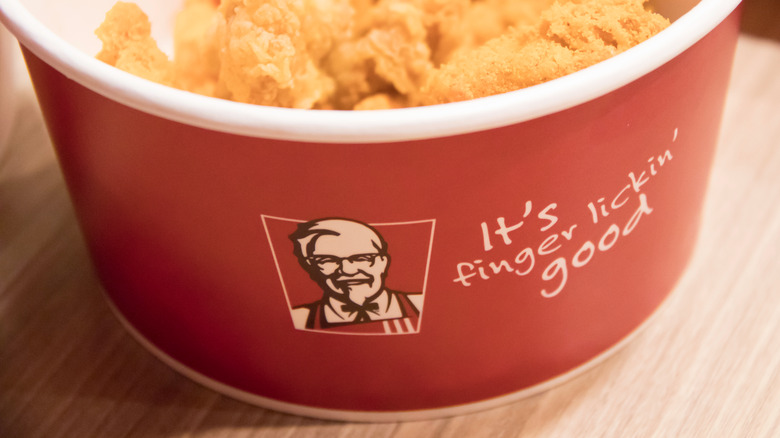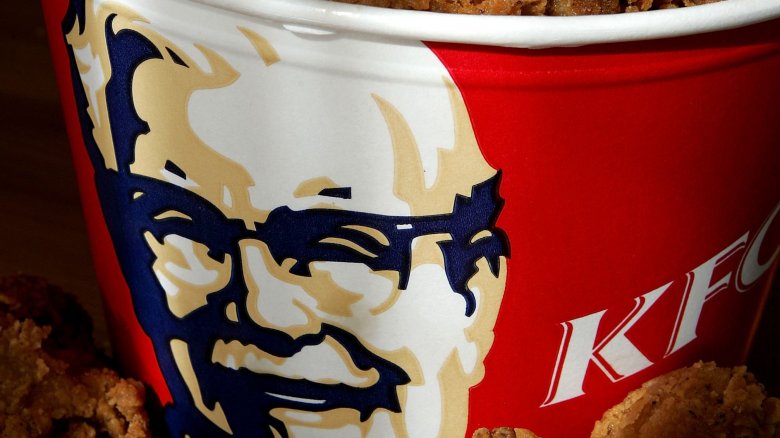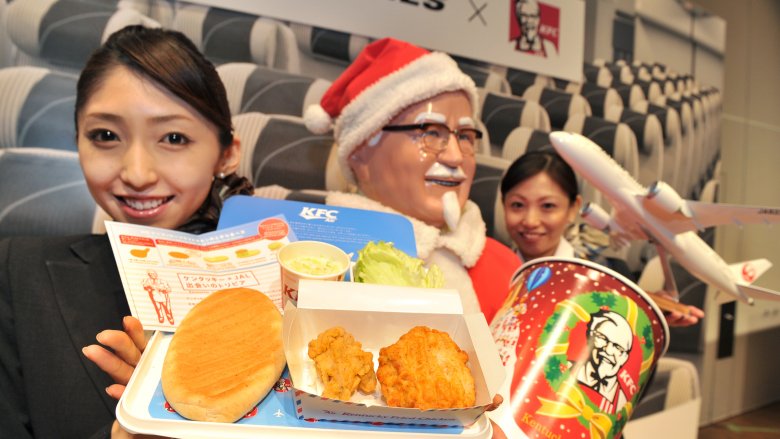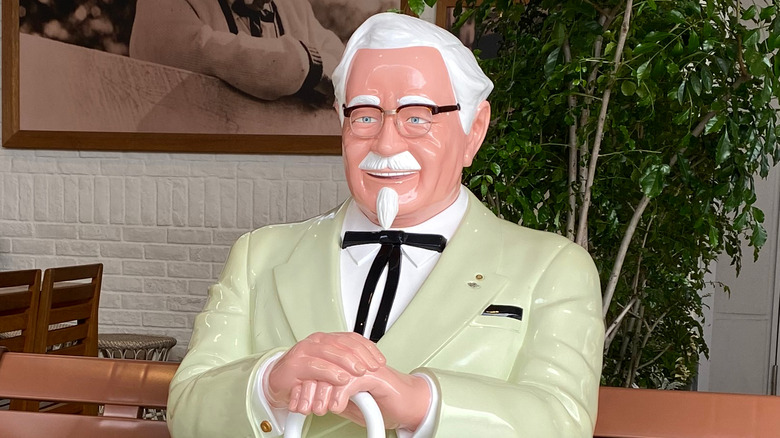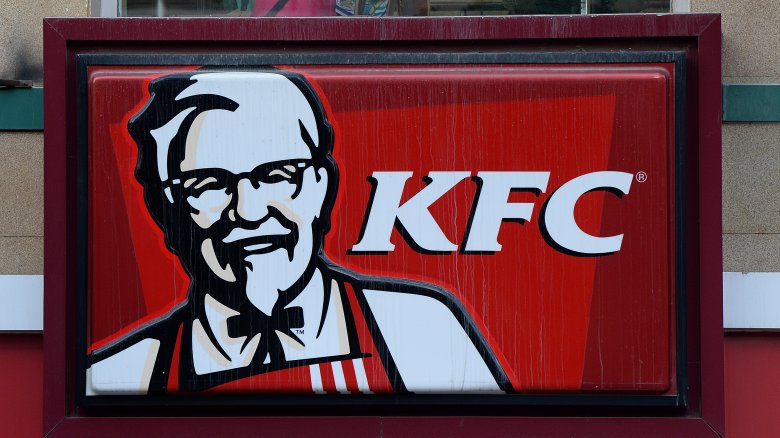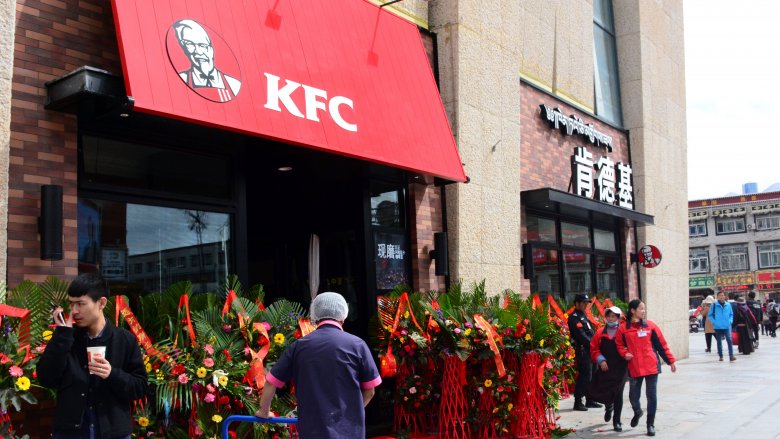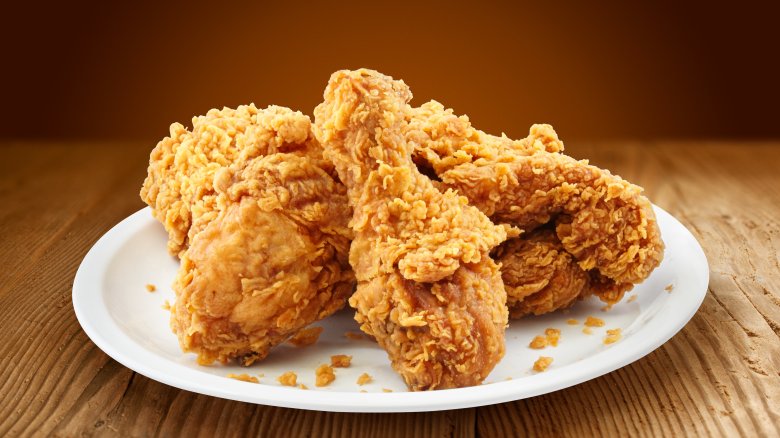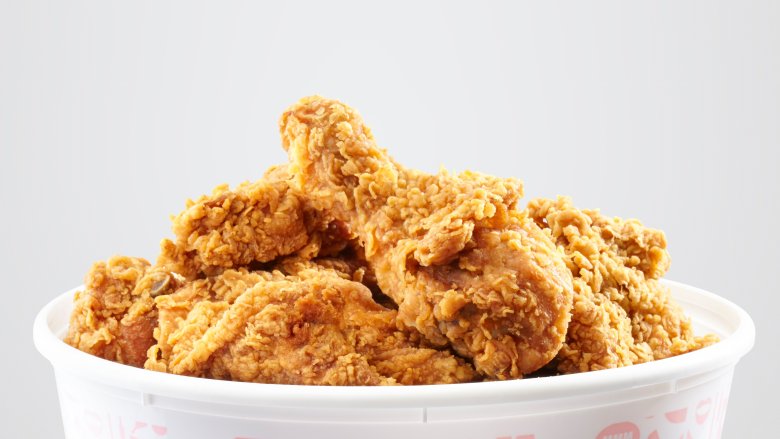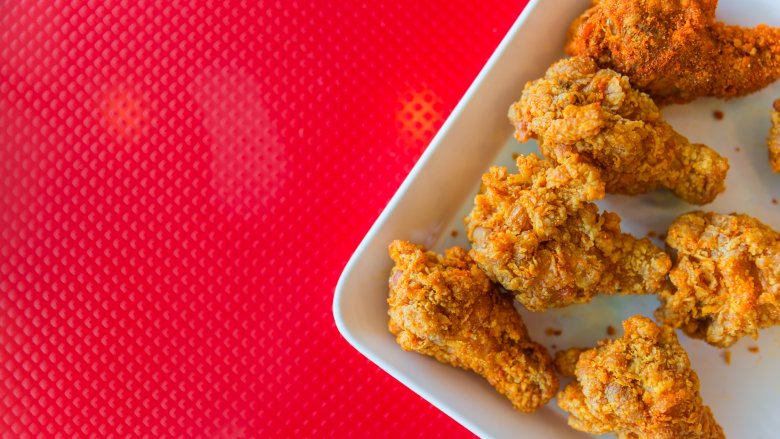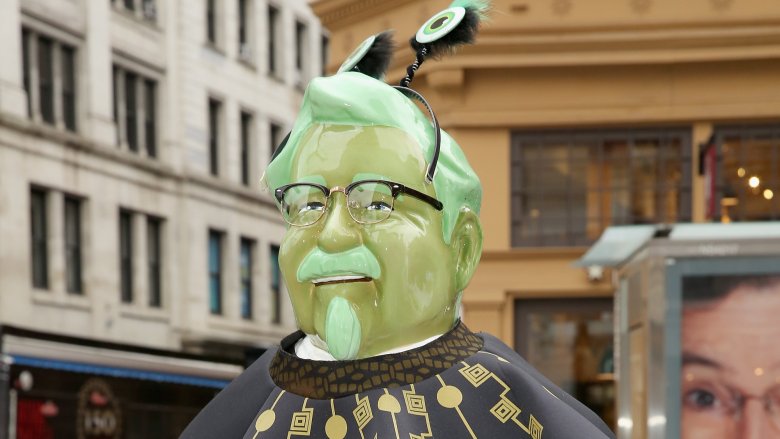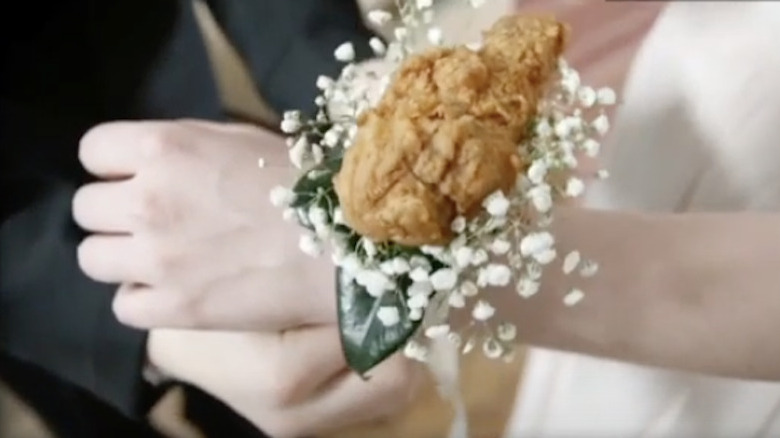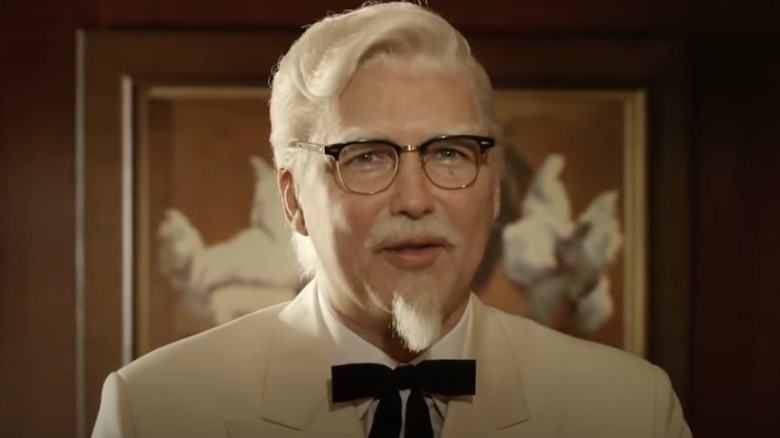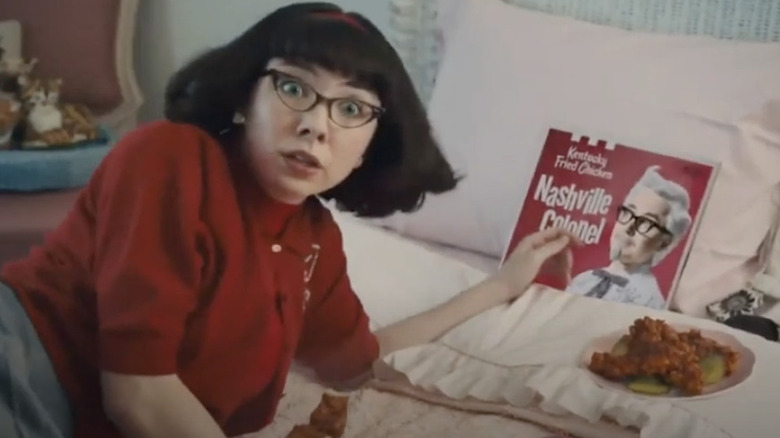The Untold Truth Of KFC
The fast food restaurant KFC — formerly known as Kentucky Fried Chicken — is known around the globe for its famous fried chicken. Its "finger lickin' good" franchises can be found in 130 countries all over the world. With more than 21,000 locations, it's safe to say that you're probably never too far from a KFC, or it's tasty (but secret) blend of herbs and spices. But while many people can say they've tasted the chicken at KFC, and pretty much everyone can identify Colonel Harland Sanders, most people don't know that the beloved chicken chain has a colorful history behind its success. There's a lot more to this chain than crispy fried chicken and a handful of delicious sides. Here is everything you never knew about KFC.
Colonel Sanders learned to cook as a child
Colonel Sanders, the iconic founder of KFC, started cooking when he was just a little kid. According to the New Yorker, after his father died when young Sanders was just 6, his mother had to take up extra work and spent a lot of time away from home. This meant he was responsible for caring for his younger siblings and was often left in charge of a lot of the family's cooking. By the time he was 7 years old, "he was excelling in bread and vegetables and coming along nicely in meat." Little did he know that this skill would one day make him a fortune.
Math made him drop out of school
All told, Sanders had very little formal education and a rough childhood. When his mother remarried, he was forced out of the house as his stepfather did not want children around. The then-12-year-old began working on a farm, making monthly wages plus room and board. At first, he balanced the work with school, but gave up on getting an education in seventh grade.
"When I started to class that fall, they had algebra in our arithmetic," said Sanders. "Well, I couldn't conceive any part of it. The only thing I got out of it was that x equaled the unknown quantity. And I thought, 'Oh, Lord, if we got to wrestle with this, I'll just leave—I don't care about the unknown quantity.' So my school days ended right there near Greenwood, Indiana, and algebra's what drove me off."
It started in a service station
Sanders would have many jobs before he began making chicken. Some of the jobs he worked at were as a farmhand, a streetcar conductor, a fireman, and an insurance salesman. In the early 1930s, Sanders was running a service station when he had the idea for KFC. A customer complained that there was no good food around, so Sanders decided to fall back on his cooking skills and convert the storage room in the service station into a small diner. He began selling ham, mashed potatoes, biscuits and — most importantly —fried chicken.
Sanders' cooking proved to be a hit. Over the next few decades the business would grow. By the time Sanders sold the company in 1964, there were more than 600 franchises.
Here's exactly why KFC's chicken is finger lickin' good
KFC is almost as well known for its deeply entrenched advertising slogan as the fast food chain is for its namesake chicken and coleslaw. For decades, the phrase "It's finger lickin' good!" has vividly described the seemingly irresistible taste of KFC's chicken. It's one that developed organically. It starts with Dave Harman, who opened his Kentucky Fried Chicken outlet in Phoenix in the 1950s, per Deseret News.
According to Creative Review, Harman would appear in local ads for the restaurant, filmed at a Phoenix TV station, eating a plate of chicken while his restaurant manager, Ken Harbough, delivered the narration. After one such commercial, a viewer complained to the station, objecting to the imagery of Harman licking his fingers while he ate. When he heard about the call, Harbough blurted out, "Well, it's finger lickin' good."
That had a nice ring to it and consequently made its way up the corporate chain, where the slogan was almost immediately used to market Kentucky Fried Chicken. Soon enough, it was printed onto countless red-and-white-striped paper buckets and distributed nationwide. KFC has used the slogan off and on over the years, discontinuing its use most recently in 2020 during the coronavirus pandemic, the BBC reports. Naturally enough, that was a time when hygiene and fighting germs felt much more important than licking one's fingers. Never fear, though — KFC brought it back in 2021.
Wendy's founder played a key role in KFC's early years
The KFC chicken bucket as we know it wouldn't have existed without help from Dave Thomas. He was a key employee in KFC's early years and came up with the idea for the iconic red and white striped chicken bucket, the streamlined menu, and the rotating chicken bucket signage. He also encouraged Sanders to appear in commercials and become the face of the brand — advice he later took himself. Thomas would later sell his KFC franchises back to Sanders and use the money to start another well-known franchise, Wendy's.
KFC is a traditional Christmas meal in Japan
If you ever find yourself spending Christmas in Japan, don't be surprised when, instead of a turkey or ham dinner, you end up celebrating with KFC, according to Smithsonian Magazine. Thanks to an aggressive marketing campaign in the 1970s, the franchise is popular in Japan — especially during the holidays. While Christmas is not an official holiday in the country, people still come out in droves for a fried chicken dinner on the holiday.
The tradition took off after a group of foreigners couldn't find turkey for Christmas and decided to eat chicken instead. KFC seized on the opportunity and began selling Christmas meals. Soon, "Kurisumasu ni wa kentakkii" (Japanese for "Kentucky for Christmas") spread throughout the country and a Christmas tradition was born. Today, people stand in line for hours each Christmas eve for a special KFC Christmas chicken dinner, which is served with champagne and cake.
Did the Colonel curse a Japanese baseball team?
KFC isn't the only distinctly American export to catch on in Japan, as baseball is extremely popular there, too. For instance, the Osaka-based professional team known as the Hanshin Tigers have a tradition in which fans celebrate big victories by dressing up as the team's stars and jumping into the Dotonbori River, according to NBC News.
In 1985, the Hanshin Tigers won the national championship, thanks in part to American power hitter Randy Bass. Now Bass, being a blonde guy with a beard, clearly did not resemble the team's predominantly Japanese fans. But Bass, with his light-colored hair and facial plumage, did happen to look a little like the KFC mascot, which gave fans an idea. "So they ran down and got the Colonel Sanders statue" from a nearby KFC, Bass told NPR, "and brought him back up, dressed him up, and there he went" — that is, into the waters of the Dontonbori River.
But breaking with tradition may have come at a price. The Hanshin Tigers failed to win the Japan Series after 1985, leading some fans to believe that the so-called "Curse of the Colonel" was to blame. And so, in 2009, a crew in Osaka searched the river and pulled out the statue, hoping to reverse the curse. It was found standing upright, although the figure was missing its legs, hands, and glasses.
The name was changed to save money
The company was originally called Kentucky Fried Chicken, but the official name is now KFC. Despite claims that the name was changed to eliminate the word "fried," thus making it seem healthier, there was a far more practical reason behind the name change. In 1990, the Commonwealth of Kentucky trademarked their name, which meant that if KFC continued to use their original name they would be required to pay licensing fees. Unwilling to comply with this, they opted to instead change the company's name to KFC, an acronym which many people were already using.
Colonel Sanders hated what the restaurant became after he sold it
Per Biography, Sanders made millions from selling KFC, but it didn't take long for him to regret his decision to sell. After visiting a franchise in New York City, Sanders said it was "the worst fried chicken I've ever seen." The gravy was similarly terrible, with Sanders calling it "nothing more than wallpaper paste."
Even after selling the company, Sanders remained the face of the brand and so he took how the business was run personally. He claimed that people recognized him wherever he went and even stopped him to complain about KFC's food.
Their Twitter account makes a nod to their secret recipe
While the KFC chicken recipe is kept under lock and key, savvy Twitter users noticed something intriguing about KFC's account. The company only follows 11 accounts, which is significant since their signature recipe consists of 11 herbs and spices. The accounts KFC follows? All five members of the Spice Girls and six men named Herb.
Mike Edgette, the person who brought this to the attention of the world, was richly rewarded by KFC, Thrillist reports. The company commissioned an oil portrait of Colonel Sanders' giving Edgette a piggyback ride. While a few other people had pointed out the joke, Edgette's tweet about it went viral so he came away with the prize. He said he planned to hang the painting in his home, over the objections of his wife, who he says thinks it's an eyesore.
There's a KFC video game
Forget what your parents told you about not playing with your food. Gamespot reports that, in 2019, KFC released an 8-bit-style game called "Colonel Quest." The game is based on a fictionalized version of Colonel Sanders' life and, according to Gamespot, is "ridiculous." Highlights of the game include "escaping a classroom, bouncing flying babies off a trampoline, and shooting your way out of a gas station gunfight."
In 2017, they released another game, this latest one in a virtual reality style meant to train the cooks for their restaurants. In "The Hard Way," users are trapped in a lodge where the voice of Colonel Sanders directs them on how to make the perfect chicken (via AdAge). Sounds like fun — except they can't leave until they get it right. Nothing like welcoming new recruits to the company with a little VR kidnapping, right?
There's an FBI file on Colonel Sanders
There's an FBI file on the KFC founder that, while accessible to the public, has entire sections blacked out. The file includes background info on Sanders as well as copies of letters he sent to FBI Director J. Edgar Hoover. The file is 15 pages long and a note at the beginning makes it clear that Sanders has never been the subject of an FBI investigation, which makes the blacked out sections even more intriguing.
The truth is probably less exciting than many would like. Sanders was a fan of Hoover and had written letters of support despite Hoover's many detractors — even inviting Hoover to help Sanders celebrate his 80th birthday. In all likelihood, those letters and the invitation are the reason for the file, according to The Verge. Nothing scandalous here, people.
Colonel Sanders has been turned into a DC comic
If video games aren't your style, you could always check out the Colonel Sanders comic books. DC Entertainment turned the KFC founder into a comic book superhero who teams up with the Justice League to fight crime.
"It's been an honor, a privilege, and just plain FUN working on the last two KFC comics," said writer Tony Bedard. "I'm super-excited the story is a trilogy now, with the Colonel planet-hopping across the DC Universe. As a former GREEN LANTERN writer, it's great to revisit Hal Jordan and the Green Lantern Corps. I've written many comics over the years, but the response to teaming up the Colonel with DC Super Heroes has been a phenomenon all its own."
KFC had sold many things that aren't exactly chicken
In the 2010s, KFC abandoned its image as a folksy purveyor of old-fashioned food. Instead, the restaurant presented itself as one whose marketing embraced Millennials, particularly one that played into the gleefully ironic weirdness of the internet and the tricky concept of virality. For example, in July 2018, KFC constructed a statue of Colonel Sanders out of cat toys, then teamed up with comedy website Super Deluxe to stream a four-hour live feed of real felines playing with the thing.
To that end, KFC also released limited lines of specialty (and very unique) products trading on its famous name, taste, and even smell. For a time, KFC sold the 11 Herbs & Spices Firelog, intended to give off a scent that reportedly smelled like the chain's fried chicken.
And in the spring of 2014, according to the Los Angeles Times, KFC offered a prom-ready fried chicken corsage. For those who actually bought it, a florist sent the corsage structure and some baby's breath, along with a $5 KFC gift card. That way, the buyer could purchase fresh fried chicken and arrange it themselves before placing the creation on their date's wrist. In 2016, per Eater, KFC held a contest in which the prize was a scented candle bearing the illustrated image of Colonel Sanders. It smelled like — what else? — fried chicken. The candle probably paired quite nicely with a limited-edition gravy-scented candle introduced three years later (via Insider).
Has everyone in Hollywood played the Colonel?
As part of its new comedy-themed approach, KFC launched an ad campaign in the mid-2010s featuring a dizzying amount and variety of well-known actors, comedians, and musicians portraying Colonel Harlan Sanders, dressed up in his signature white suit, bow tie, white hair, and matching Van Dyke facial hair.
"Saturday Night Live" master impressionist Darrell Hammond was the first on the job in 2015, reports the Los Angeles Times, although he was replaced after a few months by fellow "SNL" cast member and comedian Norm Macdonald. "I'm really upset someone didn't tell me that [I'd be recast]," Hammond later told "Opie Radio" (via The Hollywood Reporter). But then Macdonald was just as swiftly replaced by comic Jim Gaffigan. In response, Macdonald tweeted that KFC "made a big mistake replacing Darrell Hammond," as his portrayal of Sanders "was authentic and perfect."
It didn't end there, naturally. After wrestler Dolph Ziggler appeared in a wrestling-themed commercial in the summer of 2016, another "SNL" star, Rob Riggle, stepped up to play the Colonel (via AdAge). Then Riggle was out. Following him came a dizzying array of new names and faces, including, per Entertainment Weekly, George Hamilton, a gold-painted Billy Zane, Rob Lowe, Ray Liotta, Reba McEntire, Jason Alexander, Sean Astin, and Mario Lopez. All told, it may now be easier to ask who hasn't played the Colonel.
KFC rocks, '50s style
One of KFC's most memorable pitchman stints came courtesy of Vincent Kartheiser, best known for playing slimy ad man Pete Campbell on "Mad Men." Kartheiser into advertising for real when he signed on to play the Colonel in a campaign promoting KFC's Nashville Hot Chicken, according to Yahoo. Kartheiser was presented as the "Nashville Hot Colonel," a smoldering 1950s-style Southern teen idol in the mold of Elvis Presley. "Like KFC's Nashville Hot Chicken, I'm a bit of a rebel decked out in authentic Nashville flavor — a perfect combination of classic and cool," Kartheiser said in a statement (via Adweek).
The campaign featured the image of Kartheiser as the Colonel on a vintage-looking LP, so KFC went ahead and released some songs under the title "The Nashville Hot Record." According to Fast Company, the release consists of two mock-1950s early rock n' roll songs, "C-O-L-O-N-E-L" and "Nashville-Centric Boogie." Both tunes were written, produced, and performed not by Kartheiser, but by another celebrity: "Saturday Night Live" and "Portlandia" star and rock musician Fred Armisen. While KFC dropped the songs onto Soundcloud for free streaming and downloading, it also printed up a tiny run of 125 highly collectible copies and quietly placed them in record stores around the United States.
